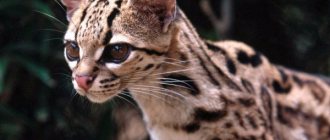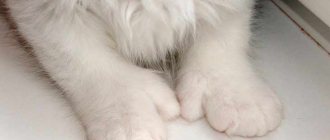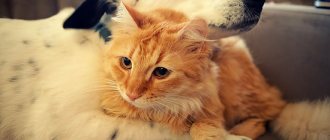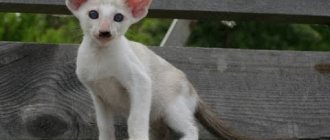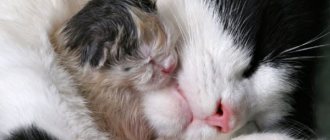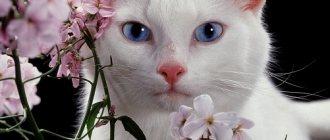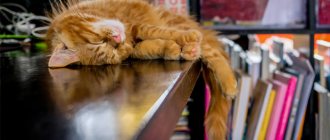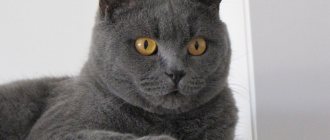History of the discovery of the species
The Andean cat (Leopardus jacobita) is a small wild cat that lives in the Andes (high mountain regions). The species was first described by the Italian scientist Emilio Cornalia in 1865. However, skeptics who did not believe in the existence of this cat demanded evidence, but it was not possible to get it. The Andean cat avoids people and other animals.
Andean cats live in mountainous areas
For a long time, ordinary people believed that such a cat existed somewhere, because animal skins were periodically found in the markets of Buenos Aires. In addition, some hunters said that they had encountered small animals. In 1980, several photographs appeared with an Andean cat in the foreground, but this was not enough. In 1998, the Andean cat was tracked by naturalist Jim Sanderson. He managed to photograph the cat for a long time because the animal ignored him.
The attention of scientists is drawn to an unusual feature of the cat. The Andean predator does not pay attention to a person if there are no signs of a threat from him. Sanderson managed to get within arm's reach of the animal.
In 2004, two more cats were discovered in the Caverna de las Brujas nature reserve (Argentina). A cat and her cub were hiding in a small cave in the mountains. The forester who discovered them managed to photograph the animals. All these facts confirmed Cornalia’s words, and the description of the species made sense, but no one was able to pick up the trail of the cat they saw twice. This predator skillfully camouflages itself and skillfully covers up traces of its presence.
In America, stories are told that Andean cats used to be killed. If an animal settled on human lands or approached a reserve, peasants and guards could stone the predator to death. All this (and the hunting of Andean cats by larger predators) led to what the cat became.
Serengeti
African grace and beauty - this is how this big wild cat can be described. The name of the breed in translation means “endless valley”, which in principle reflects the entire essence of the animal’s character: willfulness, pride and natural originality. It is interesting that the Serengeti was originally conceived as a similarity to the serval, but in practice its “progenitors” were the Bengal, Abyssinian and Oriental shorthair cats. The breed began its life in the 90s of the last century and today is the rarest in the world. There are only a few hundred of its representatives, and the number of official breeders does not exceed ten people. The cat is very graceful, curious and has obvious leadership qualities. Fearless, but at the same time unusually talkative and literally follows on the heels of her master.
Description of the Andean cat
The mountain cat is considered a relatively small animal. The length of its body reaches only 60–65 cm, and the height at the shoulders does not exceed 35–36 cm. The cat’s tail can be up to 45–48 cm. The weight of the animal is 4–5 kg (females can be a little lighter). Rare individuals reach 6 kg.
Andean cats are not very large
External data of the animal
Like other predators, the Andean cat has a wild appearance, although it cannot be called bright. The entire appearance of this predator suggests that the animal wants to remain unnoticed. The cat's coat is long and fluffy (hair grows up to 4 cm), but the color depends on the area in which the animal lives. The main background of the coat is silver-gray, and there are spots on it (different subspecies have spots of different colors). Brown, red or dark gray spots cover the cat's back and sides. Dark markings appear as broken stripes or spots forming stripes. The chest and belly are lighter; on the dense and muscular limbs there are horizontal stripes of a dark color (almost black).
The tail of the Andean cat is lush, the hairs on it are up to 3.5 cm long. There are dark rings throughout the tail, and the tip of the tail is black. The ears of a mountain cat are colored gray. Externally, these ears do not look like triangles, but rather like ovals. However, the peculiarity of the predator is not in the shape of the ears, but in the development of the ear apparatus. The eardrum of this cat is designed in a special way, thanks to which the cat hears the finest sounds.
In general, the head of an Andean cat is not proportional to the body; it appears small, like the head of an ordinary domestic cat. The animal's narrowed eyes are set relatively wide and on the midline of the muzzle. The muzzle itself is long, and the nose looks large (like the nose of a teddy bear). The mustache pads hardly stand out.
Photo gallery: Andean cats in different habitats
Andeans living where there is a lot of sand and clay are almost evenly colored
cats living on clay hills are painted in rusty colors, blending into the landscape
cat species that live in gorges with gray rocks are gray-brown in color
Andean cats are distinguished by a color that can “get lost” in its environment
Predator character
As it became clear from the words of the researchers, Andean cats are very secretive. Hyper-caution is due to the need to survive in an aggressive world, where large predators can attack a small animal. These inconspicuous animals are forced to hide in bushes or tall grass. This is why the species is so poorly studied.
Apparently, Andean cats lead a solitary lifestyle. It is common for animals with this way of life to protect their territory, where the animal hunts, sleeps and reproduces. In addition, the Andes protect their areas from invasion and from individuals of their own species. However, animals of the opposite sex are always allowed to enter the territory. Nature has instilled in the predator the desire to preserve its species.
In Bolivia (near the Eduardo Avaroa Nature Reserve), the Andean cat is known as Q'uita gato. In Bolivia, a related Andean species, the Pampas cat, is also called the same way. Q'uita gato is translated as "cat that runs away." Moreover, local residents cannot really distinguish between these animals. When a survey was conducted in Bolivia on this topic, only 17.4% of respondents were able to name a few main differences.
Lifestyle of the Andean cat
Surprisingly, Andean cats are believed to hunt both at night and during the day. It is especially common to look for food in high mountain areas: there are few animals suitable for food there. This state of affairs is further aggravated by the fact that the Andean predator lives in harsh climatic conditions. After all, in order to catch, for example, a rodent high in the mountains, he needs to climb to these heights himself. By the way, this is another reason why the species is so poorly studied.
The Andean cat has to adapt to difficult natural conditions
The mountain animal is endowed with a whole arsenal of tools necessary for survival: excellent hearing, a keen sense of smell and acute vision. A thick fur coat protects its owner from the cold, and the animal uses its fluffy tail as a blanket (if it suddenly had to settle down for the night in a cold area). In addition, such a tail is also used for balancing.
The mountain predator is very similar to a happy house cat, but they have completely different lifestyles. A wild cat is dexterous, he can hide every time he hears some rustle. Each Andean occupies a certain area (up to 40 km2). The cat marks its territory. And the lair is usually set up where no one can reach it (rock crevices, rocky embankments, thickets of mountain bushes, etc.).
What and how does the Andean cat eat?
The Andean cat needs a lot of energy to survive. Being in shape is vital for a predator. Only in this way will the animal be able to feed itself and its offspring and elude the aggressors in the event of an attack. To catch suitable prey for itself, the cat needs to hide and wait. The victim will give himself away: with a rustle and a smell.
Andean cat attacks its prey from hiding
If a cat hunts a very small animal or bird, then you don’t need to wait long. The Andean can overtake its prey in one leap. Typically, a cat's lunch consists of birds, their eggs and small mammals. In a hungry year, the Andean cat will not disdain insects and reptiles (and even some plants). But the most common prey of this animal are chinchillas or viscachas.
Fun fact: Cats can hunt at night because their eyes can reflect light. It is precisely those living creatures that do not have such an ability that become prey for cats. To prevent a cat’s eyes from “mirroring” in the dark, nature made them squint: the animal should not give itself away with glare.
Like Geoffroy's cat, the Andean predator uses the same place as a toilet. Thanks to this feline feature, scientists were able to study the nuances of nutrition. So we found out that the cat most often consumes viscacha, phyllotid mice and tinamou birds. Their DNA was found in excrement. The science that studies such nuances is called molecular scatology.
Reproduction
Due to the difficulties in observing cats, there is little information about the breeding of Andean cats. Researchers agreed that the breeding season for cats occurs from late spring to early summer. The female can give birth to up to three babies. They reach sexual maturity at the age of two years.
The peak breeding season for Andean cats is April-July
Scientists have not found confirmation of the fact that males help feed and raise offspring, so it is believed that females do this. There is little information about at what age a kitten begins to live independently, but presumably this occurs before the kitten reaches two years of age.
Lifespan in the wild
There is no reliable information about the life expectancy of Andean cats in their natural environment. The closest relative of the Andes, the Pampas cat can live up to 10 years. Although in captivity the Pampas cat can live even longer. There are known cases when a pampass lived up to 16.5 years next to a person. In theory, the average lifespan of these species may be the same.
The lifestyle of Andean cats does not allow us to calculate how many years they live
Chausi (chausie)
One of the most expensive breeds in the world, officially recognized only in 2003. It is considered a hybrid, bred by crossing the Bengal, Savannah, Abyssinian and ordinary domestic cats. The result was an animal with a domestic character, but inside retaining the temperament of a savage. It is very difficult to breed and is practically not found in the post-Soviet space. Many features of the Chausi have been preserved from her distant ancestors: long strong legs, proud and graceful posture, high cheekbones and large ears that catch the slightest shades of sounds. Cats are active, inquisitive, love heights and are ready to jump on the mezzanines of closets and the backs of sofas for hours. They do not tolerate loneliness well, missing everyone in the household.
Habitat and role in the ecosystem
The American predator lives mainly in Bolivia, but some populations have been found in Bolivia and Argentina (northwestern part of the country), as well as in Chile and Peru. For living, the cat chooses a rocky valley, near which there are slopes and ridges (hills, stones, etc.). It will not be difficult for the animal to climb to a height of up to 5 km. The air temperature in such places may not reach 4 degrees Celsius. Sometimes frosts are possible, but even in this case the cat will not abandon its favorite area.
The Andean cat's role in the ecosystem is to control rodent populations. It is the Andean cat that helps reduce the population of chinchillas, as well as some larger vertebrates.
There are suggestions that the cat prefers heights due to its need for water. In wooded areas and deserts, water is scarce. And going out into the open to the only available source of water is an unaffordable luxury for a mysterious cat. It is easier to find water in the mountains. Melting glaciers become a source of life-giving moisture.
Video: Andean cat in rocky terrain
Siberian
The breed acquired its current appearance both through the efforts of breeders and natural evolution, which modified the cat in natural conditions. She is equally suited to both statuses - wild and domestic. The first standard was announced in 1988. The distinctive features of the animal are a large, developed body with powerful paws, as well as long, hard and thick hair with water-repellent impregnation. To bathe such a fluffy ball, you need to try hard. The color of the “Siberian” can be different: from silver-ash to peach and red with tan. In Russia there are a lot of different color names, photos of which can be easily found on the Internet. Cats are very affectionate, friendly and have a sharp mind. They love to roam free, happily hunting birds and mice.
Life of an Andean cat in captivity
Keeping Andean cats at home is impossible. At least there is not a single successful example of this. This does not mean that people did not try to reproduce conditions for cats that were as close to natural as possible. Zoologists have attempted to keep Andeans in zoos. It would seem that it is in such specialized places that predators can be bred. At least in order to maintain and increase the number of the species. But Andean cats cannot live in zoos either. The longest lifespan of this cat in captivity is 1 year. At this age, the animal does not even have time to become sexually mature, so breeding is out of the question.
The Andean cat cannot be purchased legally. If you are offered to buy a mysterious kitten, keep in mind that the seller faces criminal liability. In addition, purchasing an even beautiful, but complex predator for home keeping is pointless. Under any given conditions, the cat will get sick and die. This situation will persist until the species is studied in more detail and its numbers increase.
I have friends who keep a wild cat in their yard. It is difficult and dangerous, but risk factors cannot influence the decision of animal owners. But I believe that acquiring a representative of a rare species is at least inhumane.
Video: Andean cat in the zoo
Nutrition
Pallas' cats are real predators. They feed on fresh game, which they hunt down themselves. The menu consists of mice, small rodents and birds. It happens that you come across a gopher, and it’s even better if you manage to catch a hare. But such luck does not always occur.
If an unsuccessful hunt occurs in the summer, then the steppe cat is not too upset; he can also dine on insects. True, then you have to eat more of them, but it is also easier to catch them. Sometimes Pallas' cat eats grass, but this is not at all because they are trying to get enough; most likely, this is how he cleanses his stomach, which becomes clogged with wool.
Number of species leopardus jacobita
Naturalist researchers suggest that the number of Andean cats does not exceed 2,500 individuals. The natural enemies of these animals are unknown, but there is evidence that humans played a negative role in reducing the number of the species. One version of why this happened is that the Andean people began to die out due to insufficient food. People exterminate rodents that wild predators feed on. In particular, chinchilla fur has long been highly valued on the world market.
The Andean cat is one of the rarest species that inhabit South America. The species is listed in the International Red Book. Appendix I of the CITES Convention contains a list of all rare animals, and the Andean cat is listed on the most restrictive list of the appendix. According to the document, trade in this species is strictly prohibited.
In 2004, the Alliance for the Study and Conservation of the Andean Cat was created. The alliance includes conservationists from Argentina, Bolivia and other countries where cat tracks were found. Perhaps a solution will soon be found to how to preserve and increase the numbers of this most mysterious of species.
The Andean cat is a wild carnivore from the cat family. This is a small animal that has the most inconspicuous appearance. The Andean cat can blend in with nature thanks to its talent for camouflage. Such animals can be called survival specialists, because they have to hide, feed and reproduce in the harshest climatic conditions. No matter how hard people tried, they were unable to tame such an animal. This animal cannot survive in the conditions offered by man. In addition, buying and selling a cat of a rare species is considered a crime.
Savannah
One of the wildest and most exotic cat breeds, in which the blood of the temperamental and freedom-loving African serval flows. The official date of appearance of the standard is considered to be 1986, but Savannah received its official recognition only in 2001. Externally, the cat looks very striking and thoroughbred due to its characteristic color and noble posture. She is energetic, cunning, agile and has remarkable intelligence. It is endowed with amazing jumping ability, and its habits are similar to its distant relative - the cheetah. Adults can reach a weight of up to 14 kg. In terms of intelligence and intelligence, it is more reminiscent of a dog than a cat. He gets along well with a leash, loves to swim and is quite easy to train.
Bengal
The result of crossing an Asian leopard cat and a short-haired domestic cat. The ancestors of this breed continue to lead a wild lifestyle, but their “heirs” are perfectly domesticated and, perhaps, have retained only their unusual color and flexible powerful body from the old days. The fur of the Bengal cat deserves true admiration - smooth, shiny, dense texture and characteristic coloring in the form of spotted tans of a golden-orange hue. This mini-leopard has a tolerant character, which allows him to get along even with dogs. Due to its genetics, the animal loves to climb trees, is not afraid of water and has an instant reaction.
Manul
Pallas's cat (Otocolobus manul, Pallas's cat) belongs to the subspecies of small cats and is included in the Red Book because it is an endangered animal. The beautiful thick fur of this predator (up to 7 cm in length) of gray or reddish-brown color with silver tips has made it a desirable prey for hunters for valuable fur. This fur saves animals from frost in their natural habitats. This species of feline hunts birds, hares, marmots, mice, badgers, lives for about 10 years, weighs about 5 kg with a length of 65 cm, and reproduces in the spring.
If you are seriously considering bringing a Pallas's cat into your home, check out the arguments against it:
- Manul is a nocturnal hunter, so he won’t let you sleep at night.
- This type of cat loves space; it is not suitable for keeping in an apartment; it needs a large yard.
- Sheds heavily.
- While playing and sharpening its claws, the animal will ruin all the furniture and curtains in the house.
- He has an aggressive character; neither other pets, nor you, nor your children will get mercy from him.
- It is unlikely that you will be able to find a cat to mate with, or vice versa, and the hormones playing in the spring will drive him into rage and severe aggression.
- Veterinary medicine is not very familiar with Pallas' cats, so in case of illness, it is unlikely that you will be able to find a veterinarian who can cure it.
- You will have to think carefully about the cat’s diet so that he does not get sick and develops properly; regular cat food will not suit him.
- This animal is listed in the Red Book, therefore it is not sold legally, and an illegally imported cat is very expensive (up to 6.5 thousand US dollars), may be infected with some disease or exhausted and exhausted.
There are several reviews on the Internet of people who have domesticated Pallas's cat, but they all note the evil nature of the animal.
Cheeto
A real Tarzan cat, inherited from its descendants a courageous disposition and domestic obedience. The breed appeared as a result of crossing a Bengal cat and an Ocicat. The external resemblance to cheetahs is no coincidence, although many generations separate it from its wild relatives. Despite their fearless nature, such cats do not live independently in nature, although their behavior is very willful and energetic. Chitos are smart, devoted to their owners, willingly allow themselves to be petted, and are distinguished by their enviable obedience. A distinctive feature of this breed is that the males show tender care for the kittens - a rather rare phenomenon in the cat “world”.
Bombay
A domestic mini-panther is the first thing you want to say when you see this cat. Work on developing the breed began in the USA back in 1956, and only after 20 years of painstaking breeding experiments did it receive the long-awaited standard. The result of crossing the Burmese and the American Shorthair cat was the beautiful Bombay - perfectly black, orange-eyed and incredibly graceful in her posture. The cat's fur is so smooth and shiny that it feels as if it has been treated with a special mastic. Animals of this breed are very affectionate, sociable and active. They also have a high sense of self-esteem, not tolerating unnecessary liberties with themselves, especially from children.
Pixie bob
The breed was registered in 1995, although trial crossings were carried out long before official recognition by TICA. The cat's name translates as "elf with a short tail." In addition to the chopped off tail, the uniqueness of the animal is given by the mischievous tassels on the ears, making it look like a wild lynx. Because of the lowered eyebrows, the muzzle seems somewhat gloomy and gloomy, although in fact the cat has a cheerful, kind and inquisitive character. She is very tactful and self-possessed, easily gets used to a leash, loves to talk and play active games. For all its openness, the pixie-bob is wary of strangers, but this quality is inherent in them, rather from a jealous attitude towards the owner than from distrust or suspicion.
Outbred champions
The record holder included in the Book of Records is a simple smooth-haired cat, Mr. Pibbles. As an adult male, he weighs only 1.5 kilograms. The length of Mr. Pibbles from the tip of his nose to the base of his tail is 15 cm. The little one lives and lives in the American state of Illinois. According to scientists, the cat's growth slowed down as a result of a congenital genetic mutation.
Mr. Pibbles' main competitor in the fight for the miniature crown is the kitten Heed, who lives in San Diego. The cute baby is 8 centimeters tall and weighs less than a kilogram. But he is still too young to become a record holder.
Another outbred little native of Illinois is the Tinker Toy cat, 18 centimeters long and weighing only 680 grams.
Kanaani
The birthplace of this breed is Israel. It was based on the genes of a Bengal, Abyssinian cat, Ocicat, as well as a wild Libyan cat and outbred individuals. The result of this “vinaigrette” was a cat with a very interesting character and appearance. The color of the animal can change from apricot to chocolate, but several details must remain unchanged - three rings at the tip of the tail, black socks on the paws, a necklace on the neck. The forehead is necessarily decorated with a clearly visible pattern in the shape of the letter “M”. Despite all the kindness, playfulness and affection, the cat is quite stubborn and self-confident. She does not like to sit on her lap for a long time, moves a lot and organically cannot stand loneliness. He quickly learns household rules and becomes attached to a person.
In addition to the above names and photos of wild cats, there are a number of breeds that are still classified as experimental. It is quite possible that in the near future this list will be replenished with new interesting representatives of the cat family, which will be among the pets in many families around the world.
